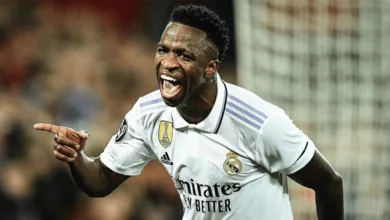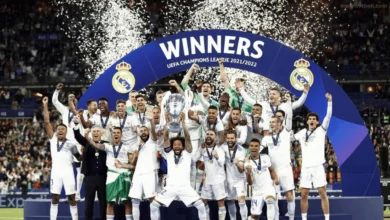Real Madrid’s Transfer Strategy Explained: How They Build Championship Winning Teams

Real Madrid, one of the most successful football clubs in history, has long been known for its bold transfer strategy. Over the decades, the club has built numerous championship-winning teams through a combination of signing world-class superstars and nurturing homegrown talent. Their approach to transfers has evolved over time, yet the philosophy of consistently competing for the biggest titles has remained the same.
Table of Contents
In this article, we’ll take a deep dive into Real Madrid’s transfer strategy, exploring how the club identifies targets, their approach to young talent, the famous “Galácticos” policy, and the recent focus on sustainable, long-term team-building.
The Foundation: A Mix of Global Stars and Homegrown Talent
Real Madrid’s transfer strategy is deeply rooted in the belief that to win the biggest trophies, you need a team that combines the world’s best talent with homegrown players who understand the culture and values of the club. This mix of international stars and academy products has been a cornerstone of their success, ensuring that there’s a balance between flair and stability.
The Importance of “La Fábrica” (The Academy)
Real Madrid’s youth academy, La Fábrica, has produced some of the most iconic players in world football, including Raúl, Iker Casillas, and more recently, Dani Carvajal and Federico Valverde. While Real Madrid is famous for splashing out on superstar signings, they also place significant emphasis on developing players from within.
These academy graduates often provide the backbone of the squad, bringing stability and continuity to the team. While high-profile signings may grab the headlines, it’s the homegrown players who often play a crucial role in maintaining the club’s identity. This combination of investing in both youth development and international talent is central to Real Madrid’s long-term success.
The Galácticos Era: A Bold Approach to Transfer Strategy
Perhaps the most famous period in Real Madrid’s transfer history is the “Galácticos” era, which began in the early 2000s under the presidency of Florentino Pérez. During this time, the club made a conscious decision to sign one global superstar every summer, resulting in the arrivals of players like Luís Figo, Zinedine Zidane, Ronaldo, David Beckham, and Cristiano Ronaldo.
The Objective Behind the Galácticos Policy
The rationale behind the Galácticos strategy was twofold. First, Real Madrid sought to assemble a team of the world’s most marketable and talented players to dominate both on the pitch and off it. Second, the club wanted to boost its commercial appeal globally, turning Real Madrid into the most valuable football brand in the world.
While the Galácticos era brought immense commercial success and global popularity, the results on the field were mixed. Despite winning the 2002 UEFA Champions League with Zidane’s famous volley, the team struggled to consistently dominate in Europe during this period.
The Shift Toward Young, Emerging Talent
In recent years, Real Madrid’s transfer strategy has undergone a significant shift. While the club still targets global stars, there has been a marked change in their approach toward signing young, emerging talents. This new strategy prioritizes long-term success, with an eye on the future rather than just short-term gains.
Key Signings of Young Stars
In the past few seasons, Real Madrid has focused on acquiring young talents such as Vinícius Jr., Rodrygo, and Eduardo Camavinga. These signings represent a more sustainable approach to team building, as the club looks to develop players into future world-class stars. By signing players at a younger age, Real Madrid can mold them into the specific style and demands of the club.
This strategy has already borne fruit, with Vinícius Jr. and Rodrygo playing pivotal roles in the club’s recent successes, including the 2022 UEFA Champions League title. Camavinga has also impressed, showing great versatility and maturity despite his young age.
The Role of Established Stars in Real Madrid’s Transfer Policy
While Real Madrid has shifted focus to younger talent, the club still recognizes the importance of experienced, world-class players in securing titles. Signing top-tier talent remains a critical part of their transfer policy, and the likes of Toni Kroos, Luka Modrić, and Karim Benzema have provided the leadership and quality needed to maintain the club’s high standards.
The Example of Eden Hazard
Real Madrid’s signing of Eden Hazard in 2019 from Chelsea is an example of their continued pursuit of established stars. Although Hazard has struggled with injuries since arriving, his transfer showcased the club’s desire to blend emerging talent with proven world-class players. However, the club has become more strategic in its pursuit of such players, balancing the need for immediate impact with long-term development.
Real Madrid’s Transfer Strategy in the Post-Cristiano Ronaldo Era
The departure of Cristiano Ronaldo in 2018 marked the end of an era for Real Madrid. Ronaldo had been the focal point of the team for nearly a decade, and his departure left a significant void. Rather than attempting to replace him with a single player, Real Madrid opted for a more balanced approach, spreading the responsibility across the squad.
Investment in Defensive Stability
After Ronaldo’s exit, Real Madrid invested heavily in their defense, with the signings of Éder Militão, Ferland Mendy, and the return of Dani Carvajal from injury. The club understood that building from the back would be crucial in their quest to continue winning trophies. This defensive solidity, combined with the flair of their younger forwards, has helped Real Madrid maintain their place among Europe’s elite.
A New Look Attack
With Ronaldo gone, players like Vinícius Jr. and Rodrygo were given the chance to shine in the attacking roles. The signing of Luka Jović also showed Real Madrid’s intent to invest in younger attacking talent. Although Jović hasn’t yet reached his full potential, the club’s willingness to give young forwards opportunities highlights their long-term planning.
Financial Power and Smart Negotiations
Real Madrid’s financial power has always been a major factor in their ability to build winning teams. The club’s ability to generate revenue through commercial deals, broadcasting rights, and matchday income allows them to compete for the most sought-after players in the market.
However, Real Madrid’s transfer strategy is not solely about spending big. The club is known for its smart negotiation tactics, often securing players at a lower price by taking advantage of market opportunities. An example of this is the signing of Toni Kroos from Bayern Munich for just €25 million in 2014, which is now considered one of the best bargains in football history.
Balancing Short-Term Success with Long-Term Sustainability
One of the key challenges for any football club is balancing short-term success with long-term sustainability. Real Madrid has mastered this art by combining immediate impact signings with future-oriented investments. The club recognizes that to remain at the top of European football, they must not only compete in the present but also build for the future.
Conclusion: A Winning Formula
Real Madrid’s transfer strategy is a winning formula that blends star power with long-term planning. While the Galácticos era defined their bold approach, recent years have seen a shift toward signing younger talent to ensure sustained success. The club’s ability to combine financial muscle with smart negotiations allows them to remain competitive in the ever-changing landscape of world football.
As Real Madrid continues to evolve its transfer strategy, one thing remains clear: the club’s pursuit of excellence will always drive them to build teams capable of winning championships. Whether it’s through signing the next global superstar or nurturing their homegrown talent, Real Madrid is set to remain a dominant force in world football for years to come.






